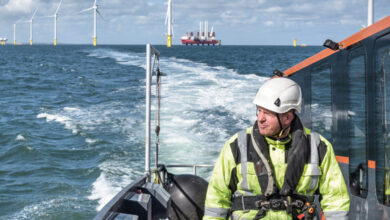Capacity and connection issues with the Northern Ireland Grid
 Dorit McCann sees a disconnect between DETI’s plans and the practical challenges for renewable grid planning identified by NIE and SONI.
Dorit McCann sees a disconnect between DETI’s plans and the practical challenges for renewable grid planning identified by NIE and SONI.
The Minister for Enterprise, Trade and Investment has set a target of 40 per cent of Northern Ireland’s electricity consumption to be from renewable sources by 2020. With this target in mind, the Offshore Renewable Energy Strategic Action Plan 2012-2020 (ORESAP) and the draft Onshore Renewable Electricity Action Plan 2011-2020 (OREAP) explore the renewable electricity potential for Northern Ireland.
In order for developers to gain the necessary investment for large scale electricity generation, as that envisaged in the ORESAP and the OREAP, there needs to be confidence that the physical and regulatory frameworks in Northern Ireland can cope with this additional generation.
With less than eight years to go, is it feasible for Northern Ireland’s electricity network to be sufficiently upgraded to accommodate such ambitious plans and for the necessary upgrades and developments to achieve the necessary consents and connections offers? Is a target measured by Northern Ireland consumption, as opposed to generation1, sensible or even feasible in Northern Ireland and in the context of the SEM?
Will the Northern Ireland grid be capable of supporting future development?
The overall aim of the ORESAP is for a development opportunity of “up to 900 MW of offshore wind and 300 MW from tidal resources in Northern Ireland by 2020” while the OREAP considers additional onshore wind, biomass and other renewable generation opportunities.
NIE2 and SONI3 have stressed the significant challenges in connecting 600MW of potential east coast offshore generation to the NIE network and have to date only assumed east coast offshore generation connection of 300 MW. NIE has also stated that investment required for connection of off shore renewable generation or large scale biomass will fall in RP6 (i.e. 2017-2022).
In addition to the required substantial expansion of the 275 kV transmission grid to achieve the 40 per cent target, there are considerable challenges in securing planning permission and the relevant consents.
Despite NIE’s and SONI’s reservations, the Crown Estate is currently tendering for 600MW offshore generation by 2020.
The timing of consents and connection offers
The practice in Northern Ireland is that a party applying for grid connection must have planning permission in place. This is a significant burden on developers and investors as planning is a crucial element in any development of renewable generating capacity. In England and Wales, National Grid accepts grid connection applications very early, usually before all consents have been achieved. This removes the burden on investors to incur costs without the certainty of a grid connection. It remains to be seen if the current custom and practice in Northern Ireland can be sustained going forward. There is an argument that with significant developments coming down the line, developers should be allowed to obtain a grid connection offer before planning permission is applied for.
The recent complaint by TCI Renewables to the Utility Regulator in relation to NIE’s connection offer for Dunmore wind farm4 has also highlighted weaknesses in the processing of grid connection offers by NIE. In its determination of 17 January 2012, the Utility Regulator encourages NIE to review its procedures for dealing with connection applications to ensure that they are dealt with in a systematic, transparent and consistent manner. The tightening of procedures must be welcomed in light of the number of connection applications and the scale of developments expected over the next few years. Strict and clear time limits must be imposed to avoid allegations of unnecessary delays or allegations of discrimination.
Comment
There appears to be a disconnect between the practical challenges highlighted by NIE and SONI and DETI’s ambitious plans. Difficult questions and decisions lie ahead and if there is any hope of the ambitious target set by the Minister to be met, they need to be made quickly to provide developers and investors with the necessary confidence.
 Dorit McCann
Dorit McCann
Head of EU, Competition and Regulation
T: 028 9034 8816
E: dorit.mccann@carson-mcdowell.com
1. The UK Renewable Energy Strategy expresses its targets by electricity generated.
2. NIE Transmission and Distribution Price Control for RP5, Capital Investment Requirements for the Fifth Regulatory Period, 4 April 2011 (RP5).
3. SONI/Eirgrid All-Ireland Generation Capacity Statement 2012-2021.
4. Determination of the Utility Regulator, 17 January 2012.





